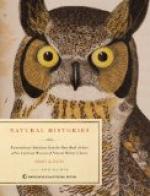The woods hold not such another gem as the nest of the humming-bird. The finding of one is an event to date from. It is the next best thing to finding an eagle’s nest. I have met with but two, both by chance. One was placed on the horizontal branch of a chestnut-tree, with a solitary green leaf, forming a complete canopy, about an inch and a half above it. The repeated spiteful dartings of the bird past my ears, as I stood under the tree, caused me to suspect that I was intruding upon some one’s privacy; and following it with my eye, I soon saw the nest, which was in process of construction. Adopting my usual tactics of secreting myself near by, I had the satisfaction of seeing the tiny artist at work. It was the female, unassisted by her mate. At intervals of two or three minutes she would appear with a small tuft of some cottony substance in her beak, dart a few times through and around the tree, and alighting quickly in the nest arrange the material she had brought, using her breast as a model.
The other nest I discovered in a dense forest on the side of a mountain. The sitting bird was disturbed as I passed beneath her. The whirring of her wings arrested my attention, when, after a short pause, I had the good luck to see, through an opening in the leaves, the bird return to her nest, which appeared like a mere wart or excrescence on a small branch. The humming-bird, unlike all others, does not alight upon the nest, but flies into it. She enters it as quick as a flash, but as light as any feather. Two eggs are the complement. They are perfectly white, and so frail that only a woman’s fingers may touch them. Incubation lasts about ten days. In a week the young have flown.
The only nest like the humming-bird’s, and comparable to it in neatness and symmetry, is that of the blue-gray gnat-catcher. This is often saddled upon the limb in the same manner, though it is generally more or less pendent; it is deep and soft, composed mostly of some vegetable down, covered all over with delicate tree-lichens, and, except that it is much larger, appears almost identical with the nest of the humming-bird.
But the nest of nests, the ideal nest, after we have left the deep woods, is unquestionably that of the Baltimore oriole. It is the only perfectly pensile nest we have. The nest of the orchard oriole is indeed mainly so, but this bird generally builds lower and shallower, more after the manner of the vireos.




